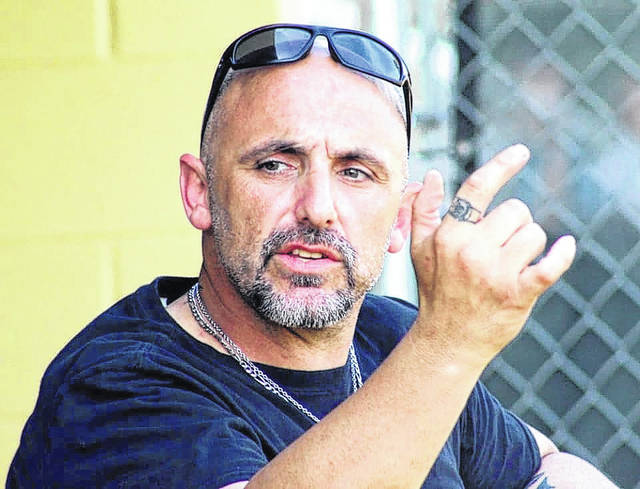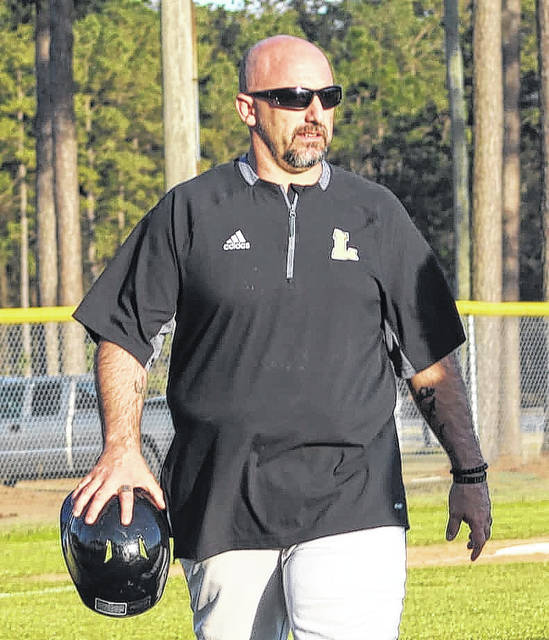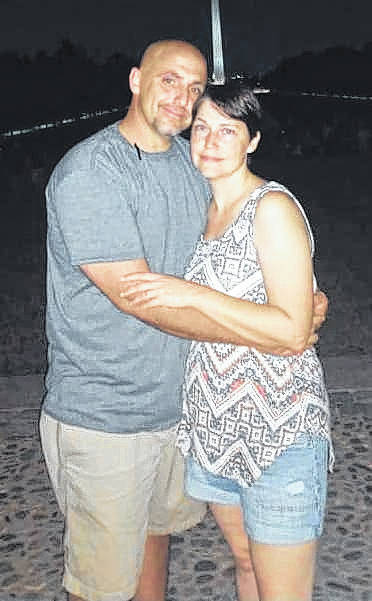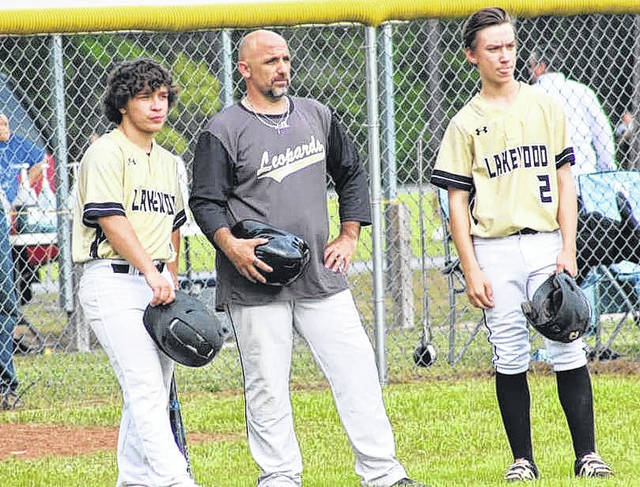The love and passion that Lakewood varsity baseball head coach Jay Faircloth has for his team and players is undeniable. Never in post-game comments — win or lose — does the fourth-year coach have anything negative to say about his players or their efforts. His love for the team was evidenced in a post on his Facebook page at the conclusion of this season when he remarked about four outgoing seniors.
“What a blessing it was for me to coach these four during their baseball careers at Lakewood!! A ton of laughs, some tears, some aggravation, but all love. I will miss you boys but always know you will always be in my heart,” he wrote.
Faircloth is happily married to his wife, Laney, and the two of them are surrounded by the love of four children — Shawn, Brittany, LJ and Kendallyn. A future son-in-law, Spencer, and new grandbaby are also on the way. It can’t go unstated that the Faircloth household is also home to four-legged family members of the canine and feline variety. Life is great for the Faircloth family.
Well, almost.
Feb. 26, 2014 was a life-changing day for Faircloth, one that he will never forget and, ironically, also one he almost never remembered.
Baseball workouts were underway as winter sports were winding down and spring sports were just around the corner. Faircloth was coaching JV baseball then and was holding a practice at the RBI Center in Roseboro.
That’s when the unimaginable happened.
“I was tossing pitches behind the L screen. The kid taking swings had missed the first five pitches. Out of nowhere, he connects for a line drive right back at me. I had no time to react.”
And there it was. In the blink of an eye, a line drive with the force of 126 mph behind it struck Faircloth’s left temple, rendering him unconscious.
“I was out for 14 minutes. I woke up to Tristan Holmes giving me Powerade and the players I remember standing over me were Chandler Ray, Josh Carter and Matthew Mitchum,” he recounted.
Faircloth was rushed to Sampson Regional Medical Center in Clinton where, interestingly enough, he was told he passed a concussion test. Not completely buying that assessment, he was released from the hospital and a few days later presented at Dr. Ken Yang’s office, where he was officially diagnosed with a grade three concussion. Dr. Yang also dropped the bombshell that Faircloth was lucky to be alive.
Faircloth then entered eight weeks of healing, including extremely limited mobility and no work. He recalled sitting or lying down all day, every day, moving only for bathroom trips. He also interjected that his pets, especially his cat he calls Punk-Punk, were therapeutic in his recovery, and never left his side.
Still, though, after eight full weeks of missing work, Faircloth was still struggling in overcoming symptoms.
“I knew something wasn’t right. I still had no memory of that day. I had mood swings, anger issues. I had jaw issues – I lost about 40 pounds because I couldn’t eat right from the jaw issues. I was getting migraines. The list goes on.”
Faircloth admits that his biggest concern was his uncontrollable anger.
“God bless my wife. She put up with a lot of anger, a lot of tears, cussing and fussing. But she stood by me.”
“I regret the way I treated people, especially my wife, but that wasn’t me. It was like I knew in my mind what I was doing but I couldn’t get myself to stop.”
Finally, Faircloth had enough.
In July of 2014, he made a visit to North Carolina Neuropsychiatry in Raleigh. There, an MRI was ordered and the discovery was something more than just a concussion. The results showed that the force of the impact from the ball had caused a kink in his temporal artery. Instead of a regular blood flow, blood was trickling through at a much slower rate.
With a clear diagnosis in hand, Faircloth was given a treatment regimen and with it a new sense of satisfaction.
And relief.
“North Carolina Neuropsychiatry is a very good place. They were honest with me and told me I’d be lucky to overcome all of my symptoms. But, after day six of steroids I was a completely different person. I don’t know what it feels like to win the lottery, but that was a pretty close feeling.”
Jumping forward to Christmas of 2018, Faircloth recounts one more stage in the recovery process.
“I woke up this past Christmas Eve and suddenly remembered everything about that day. Here we are nearly five years later and I suddenly remembered every little detail.”
Which brings us to the importance of the message Faircloth wants to spread.
“I want to convey the importance of concussion protocol,” he asserted. “They categorize concussions and I don’t think they should.”
Faircloth commented that even today he still has residual struggles.
“I cry all the time. I put on a front. I have trouble with numbers and still have trouble with memory but I do brain games on my computer to help with that. And on the field, I’m still a little gun-shy. People don’t even realize. I go out and practice — I’m still a coach so I have to go out there, but I still am gun-shy.”
Indeed, as Faircloth mentioned, concussions are categorized.
According to WebMD.com, concussions are graded as mild (grade 1), moderate (grade 2) or severe (grade 3), depending on factors such as loss of consciousness, amnesia and loss of equilibrium.
In a grade one concussion, symptoms last for less than 15 minutes and there is no loss of consciousness. With a grade two concussion, there is no loss of consciousness but symptoms last longer than 15 minutes. In a grade three concussion, the person loses consciousness, sometimes just for a few seconds.
For Faircloth, it was 14 long minutes.
“A concussion is a concussion. You’ve damaged your brain. It doesn’t matter – your brain is injured and it needs to be evaluated properly. It took me a third doctor to get full clarity on my situation,” Faircloth added.
He reinforces that his primary concern is the safety of players and that he doesn’t want to see athletes who have suffered concussions rush to get back for the sake of a game.
“Here I am five years removed from the injury and I still have symptoms. The brain is slowest thing to heal in the body. If it’s messed up, it’s messed up.”
“Winning is not everything to me — success is. And I tell my players ‘If you get hit in the head, I need to know it. I take it very serious.’”
As does the NCHSAA, especially with the urging of the North Carolina General Assembly.
The Gfeller-Waller Concussion Awareness Act was drafted and implemented to protect the safety of student-athletes in North Carolina and was signed into law on June 16, 2011 by then-Gov. Beverly Purdue. There are three major areas of focus in the law and these include: education, emergency action and post-concussion protocol implementation, and clearance/return to play or practice following concussion.
Per NCHSAA guidelines, the student-athlete must be completely symptom-free both at rest and with cognitive stress, then with full physical exertion before being cleared to resume full participation in athletics. The NCHSAA strongly recommends that all member school student-athletes have a licensed physician’s (MD/DO) signature on the Return to Play Form and/or the Licensed Health Care Provider Concussion Evaluation Recommendations Form.
Still, Faircloth would like to see more done, especially given that concussions are on the rise countrywide.
“I hope this story reaches people,” he attested. “If it’s one parent, coach, school or athlete, I want them to understand that just because you pass the protocol doesn’t mean you’re entirely good to go. I’m still not good five years later.”
“Raymond Spell was monumental in helping me on the road to improvement. I was coaching against him and out of nowhere I fired off at him for no reason right there on the field,” he recalled, regrettably.
“Parents push their kids to get back into the game and rush the process. But I say take precautions. Get checked out. I still have to do brain games four days a week and a lot of people don’t know that. They don’t know the emotional struggles I continue to face.”
“Concussions are serious and we have to be absolutely careful in handling them and the athlete suffering from it,” Faircloth concluded.




